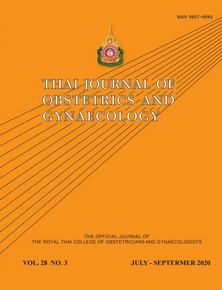Prevalence of Maternal Hypovitaminosis D and Obstetric Outcomes at Chonprathan Hospital, Nonthaburi, Thailand
Main Article Content
Abstract
Objective: The primary aim of this study was to determine the prevalence of maternal hypovitaminosis D. The secondary aim was to determine the obstetric outcomes between a group of pregnant women with hypovitaminosis D and the normal control group at Chonprathan Hospital, Nonthaburi province of Thailand.
Materials and Methods: This study was a cross-sectional study. A total of 77 subjects were consecutively enrolled in the study. The inclusion criteria were pregnant women who had received antenatal care and delivered at Chonprathan Hospital, Nonthaburi, Thailand. The exclusion criteria included women who had a liver disease, kidney disease, gastrointestinal absorption disease, pulmonary tuberculosis, hyperthyroid disease, and pregnant women who used drugs that have an effect on vitamin D. Vitamin D deficiency was defined as 25-hydroxyvitamin D (25-OHD) < 20 ng/mL, insufficiency as 25-OHD 20–29.9 ng/mL, and sufficiency as 25-OHD > 30 ng/mL. Hypovitaminosis D refer to vitamin D deficiency plus vitamin D insufficiency. A data interview was performed and the results recorded in a case record form by the research team. Venous blood samples were collected for 25-OHD, parathyroid hormone (PTH), calcium, phosphate, alkaline phosphatase (ALP), albumin, and magnesium on the day of labor.
Results: The mean level of 25-OHD was 25.2% ± 7.9 ng/mL. The prevalence of vitamin D deficiency was 22.1%, vitamin D insufficiency was 44.1%, and vitamin D sufficiency was 33.8%. There was an association between the vitamin D level and PTH and hematocrit, but no association between the other blood parameters statuses (correct calcium, phosphate, ALP, albumin, magnesium), age, pre-pregnancy body mass index, or obstetric complications.
Conclusion: The prevalence of hypovitaminosis D was 66.2%, while vitamin D deficiency was 22.1%. There was no association between the vitamin D level and obstetric outcomes.
Article Details
References
McGuire E. Vitamin D and breastfeeding: an update. Breastfeeding review. Breastfeed Rev 2015;23:26-32.
Seamans KM, Cashman KD. Existing and potentially novel functional markers of vitamin D status: a systematic review. Am J Clin Nutr 2009;89:1997S-2008S.
Hypponen E, Power C. Hypovitaminosis D in British adults at age 45 y: nationwide cohort study of dietary and lifestyle predictors. Am J Clin Nutr 2007;85:860-8.
ACOG Committee Opinion No. 495: Vitamin D: Screening and supplementation during pregnancy. Obstet Gynecol 2011;118:197-8.
Abedi P, Mohaghegh Z, Afshary P, Latifi M. The relationship of serum vitamin D with pre-eclampsia in the Iranian women. Matern Child Nutr 2014;10:206-12.
Wagner CL, Baggerly C, McDonnell SL, Baggerly L, Hamilton SA, Winkler J, et al. Post-hoc comparison of vitamin D status at three timepoints during pregnancy demonstrates lower risk of preterm birth with higher vitamin D closer to delivery. J Steroid Biochem Mol Biol 2015;148:256-60.
Cho GJ, Hong SC, Oh MJ, Kim HJ. Vitamin D deficiency in gestational diabetes mellitus and the role of the placenta. Am J Obstet Gyneco 2013;209:560.
Mehrotra P, Marwaha RK, Aneja S, Seth A, Singla BM, Ashraf G, et al. Hypovitaminosis d and hypocalcemic seizures in infancy. Indian Pediatr 2010;47:581-6.
Michael F.Holick, Neli C. Binkley, Heike A.Bischoff-Ferrari, Catherine M.Gordon, David A.Hanley, Robert P.Heaney, et al. Evaluation, Treatment, and Prevention of vitamin D Deficiency: an Endocrine Society Clinical Practice Guideline. J Clin Endocrinal Metab 2011;96:1911-30
Pratumvinit B, Wongkrajang P, Wataganara T, Hanyongyuth S, Nimmannit A, Chatsiricharoenkul S, et al. Maternal Vitamin D Status and Its Related Factors in Pregnant Women in Bangkok, Thailand. PLoS ONE 2015;10:e0131126.
Charatcharoenwitthaya N, Nanthakomon T, Somprasit C, Chanthasenanont A, Chailurkit L, Pattaraarchacha J, et al. Maternal vitamin D status, its associated factors and the course of pregnancy in Thai women. Clin Endocrinol (oxf) 2013;78:126-33.
Molina PE.Parathyroid Gland and Ca2+ and PO4- Regulation. Endocrine Physiology. 4thed. New York: The McGraw-Hill Companies; 2013.
Bowyer L, Catling-Paull C, Diamond T, Homer C, Davis G, Craig ME. Vitamin D, PTH and calcium levels in pregnant women and their neonates. Clin Endocrinol (Oxf) 2009;70:372-7.
Laqunova Z, Porojnicu AC, Lindberq F, Hexeberq S, Moan J. The dependency of vitamin D status on body mass index, gender, age and season. Anticancer Res 2009;29:3713-20.
Amegah AK, Klevor MK, Wagner CL. Maternal vitamin D insufficiency and risk of adverse pregnancy and birth outcomes: A systematic review and meta-analysis of longitudinal studies. PLoS One 2017;12:e0173605.
Bhupornvivat N, Phupong V. Serum 25-hydroxyvitamin D in pregnant women during preterm labor. Asia Pac J Clin Nutr 2017;26:287-90.
Burris HH, Van Marter LJ, McElrath TF, Tabatabai P, Litonjua AA, Weiss ST, et al. Vitamin D status among preterm and full-term infants at birth. Pediatr Res 2014;75:75–80.
Lindqvist P, Silva A, Gustafsson S, Gidlöf S. Maternal vitamin D deficiency and fetal distress/birth asphyxia: a population based nested case–control study. BMJ open 2016;6:e009733.
WHO recommendations on antenatal care for a positive pregnancy experience. 2016.
Schoenmakersa I, Pettiforb J, Rosasc J, Allardtd C, Shawe N, Jonesa K. Prevention and consequences of vitamin D deficiency in pregnant and lactating women and children: A symposium to prioritise vitamin D on the global agenda. J Steroid Biochem Mol Biol 2016;164:156-60.


